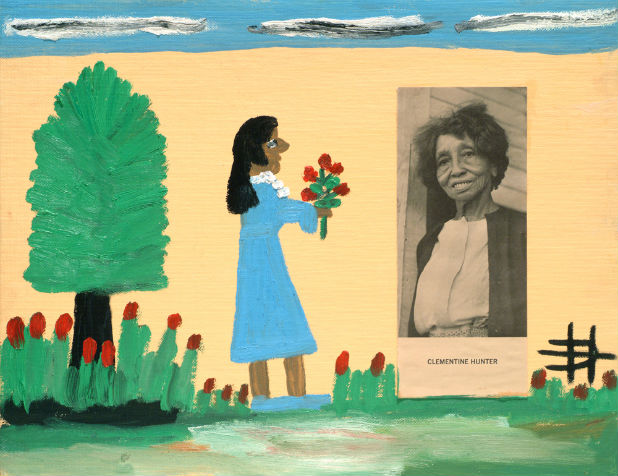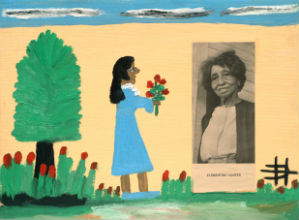
NATCHITOCHES, La. (AP) – There is nothing grand about the white tenant cabin with green trim sitting on the grounds of Melrose Plantation here. Nothing about it commands attention.
Even so, it is on the Historic Artists Homes and Studios list, along with Georgia O’Keefe’s Abiquiu House and Andrew Wyeth’s studio. It also is listed on the National Register of Historic Places – separately from the Melrose Plantation itself.
What makes the cabin notable is that it was an important part of folk artist Clementine Hunter’s spectacular career. The four-room dwelling is where she lived, painted oils and pieced together butcher paper-backed “quilts.” Where she sold homemade popsicles from her freezer and charged a nickel to use her telephone. And, of course, where she sold her paintings.
Empty and dormant for 40 years, now the cabin’s time has come. The tenant home is being restored with funding by the Gitter Gallery of New Orleans and the Cane River Art Corp. of Natchitoches.
And opening to the public. The house, formally named “The Clementine Hunter Cabin,” will be a highlight of the Natchitoches Fall Pilgrimage and Tour of Homes set for Oct. 12-14 and presented by the Association for the Preservation of Historic Natchitoches.
Hunter, who died in 1988, loved working at night. She perched on a low wooden stool, beside a quaint pot-bellied stove, as she held a homemade plywood palette in one hand and a brush to create her paintings in oil. Or she pieced together her butcher-backed “quilts,” for which she has become famous and which are still soaring in price.
Her images tell stories of Melrose Plantation and the life she knew. Of baptisms in the river, funerals, the juke joint, hog butchering and pots of zinnias. It was her world, and even an invitation from President Jimmy Carter to visit the White House could not stir her from Cane River.
Hunter never owned the house, and after almost 25 years there she left it for a trailer, the first home she owned. She moved the trailer three times before she died at age 101, painting until the end.
The cabin was across Louisiana Hwy. 119 from the plantation while Hunter lived in it. Sometime after she moved out in 1977, the house was, along with other tenant houses in the area, was headed for demolition. The late Maxine Southerland, a member of the Association for the Preservation of Historic Natchitoches, decided to move it to the plantation grounds. She then sealed it to preserve it.
Tommy Whitehead, a Hunter friend and an international expert on the artist, said it was important for the house to be sealed – and left alone.
“Nobody fooled or messed around with it or tried to ‘fix’ it. It just sat on the Melrose grounds,” Whitehead said.
The house was unsealed last spring for work to begin on opening it to the public. It now sits behind the big plantation house at Melrose and between the African and Ghana houses also on the grounds.
A ribbon-cutting for the cabin will be held at 4 p.m. Oct. 12, the first day of the three-day Natchitoches Fall Pilgrimage.
“The house is the focus of the tour, the highlight. It is on the cover of the brochure and the festival post,” said Gary Cathey, pilgrimage chairman. “People who loved Clementine will be eager to see where she lived.”
But, pointing out that hundreds of school students visit Melrose Plantation annually, Cathey is passionate about showing children that you do not have to live in a grand house to be successful – that success can come, too, to those whose homes are small.
“A lot of children don’t live in big houses,” he said. “It will be powerful for those children to see where a famous person lived and how she used her voice and talent and spirit to tell her story. Look where it took her and changed her life and the story of that plantation.”
From that little house and her seat by the stove, Hunter’s images leaped onto the pages of a UNICEF catalog and the walls of the Louvre in Paris and the American Museum of Folk Art in New York, to name just a few.
In July, Hunter was posthumously inducted into the Louisiana Folklife Center Hall of Master Folk Artists.
And her works continue to draw attention. “Clementine Hunter: Life on Melrose Plantation Exhibition” opened recently at the Smithsonian National Museum of African History and Culture on the National Mall in Washington, D.C. Thirteen of her paintings will remain on display for a year.
Thousands of paintings bear Hunter’s name and her inspiration comes from her personal experiences, says a news release from Kassie Edwards, a research assistant in the Office of Curatorial Affairs at the museum.
“She was born in Louisiana when the rigors of sharecropping and plantation labor, the highs and lows of daily life and the role of the church as a source of spiritual support were common experiences for many African American,” Edwards said.
___
By MAGGIE MARTIN, The Shreveport Times
Information from: The Times, http://www.shreveporttimes.com
Copyright 2018 Associated Press. All rights reserved. This material may not be published, broadcast, rewritten, or redistributed.
AP-WF-09-29-18 1512GMT



